Sociology of Law and Order: A Study on Migrant Workers in Singapore
VerifiedAdded on 2021/09/14
|17
|5307
|92
Report
AI Summary
This report provides a sociological analysis of law and order, specifically focusing on the experiences of migrant workers in Singapore. It examines the interconnectedness of security and migration, exploring how migrant workers are often perceived as a threat due to their perceived differences and societal biases. The report delves into the securitization of migration, highlighting how states invoke fear to justify the control and administration of migrant bodies. It analyzes the reasons why temporary migrant workers are sometimes viewed as criminals in Singaporean society, referencing studies and articles that discuss the challenges faced by these workers, including wrongful treatment, exploitation, and the impact of their temporary status. The report also examines the strategies migrants employ to navigate these challenges, and the role of international and local news sources in shaping these perceptions.
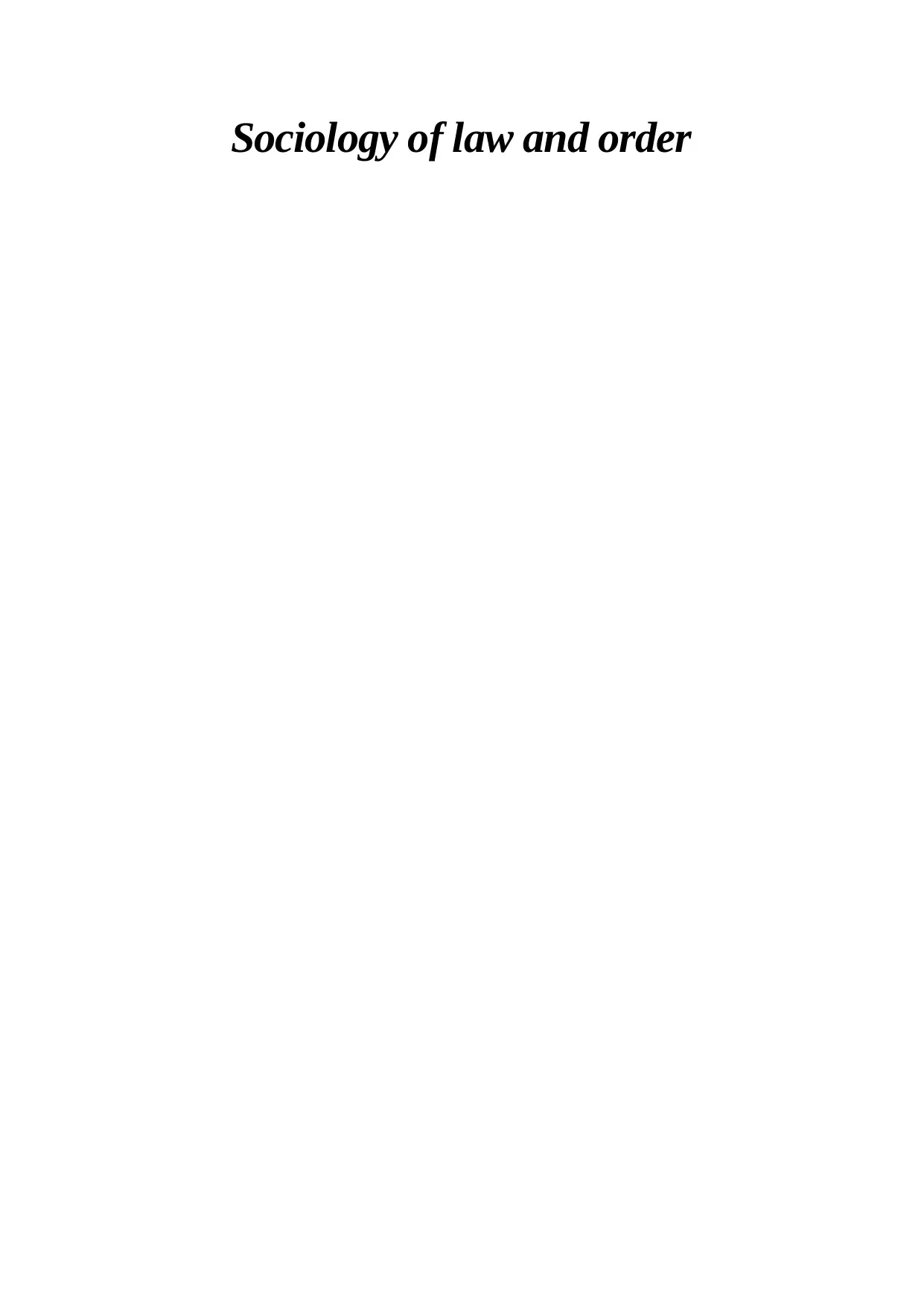
Sociology of law and order
Paraphrase This Document
Need a fresh take? Get an instant paraphrase of this document with our AI Paraphraser
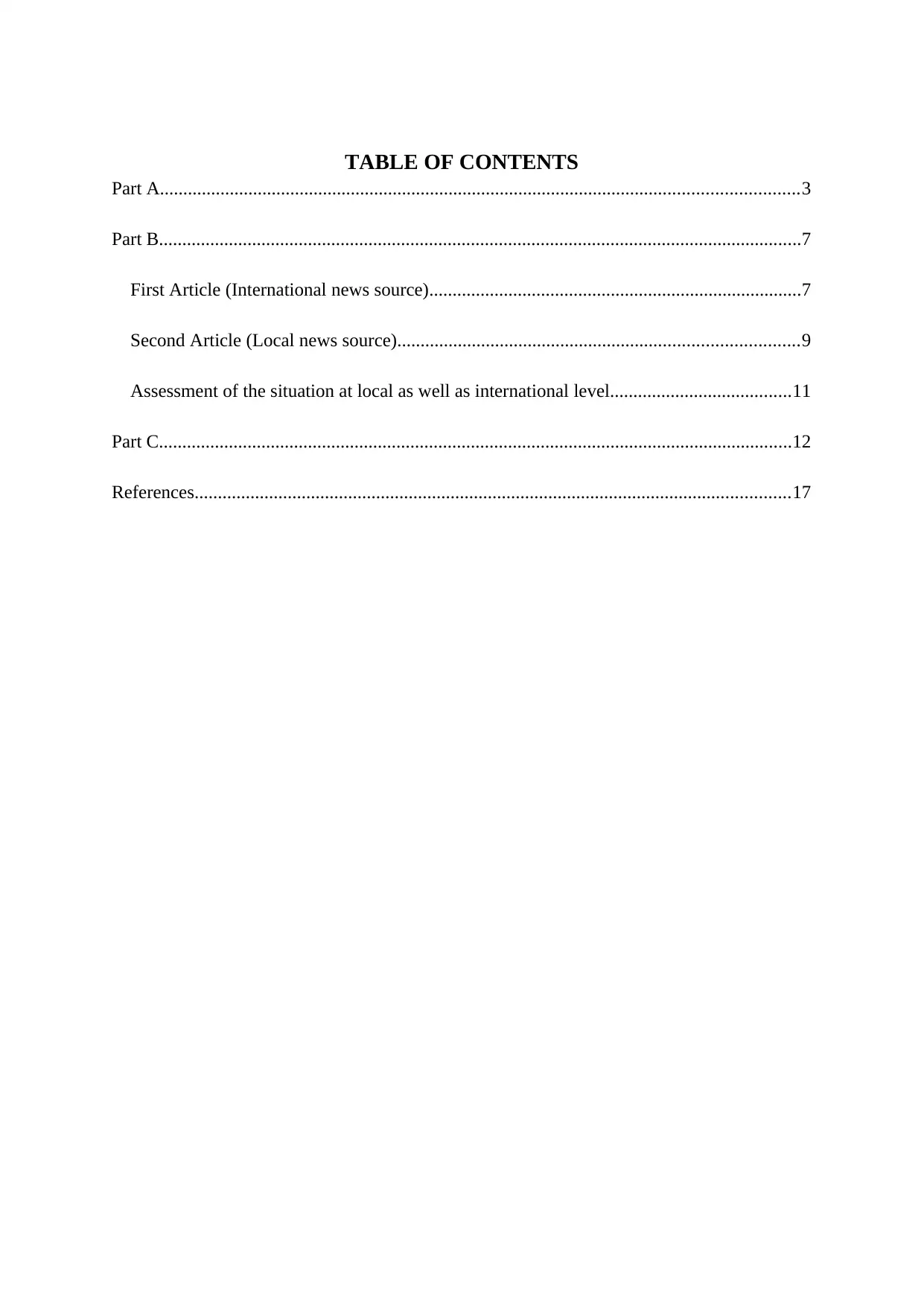
TABLE OF CONTENTS
Part A.........................................................................................................................................3
Part B..........................................................................................................................................7
First Article (International news source)................................................................................7
Second Article (Local news source)......................................................................................9
Assessment of the situation at local as well as international level.......................................11
Part C........................................................................................................................................12
References................................................................................................................................17
Part A.........................................................................................................................................3
Part B..........................................................................................................................................7
First Article (International news source)................................................................................7
Second Article (Local news source)......................................................................................9
Assessment of the situation at local as well as international level.......................................11
Part C........................................................................................................................................12
References................................................................................................................................17
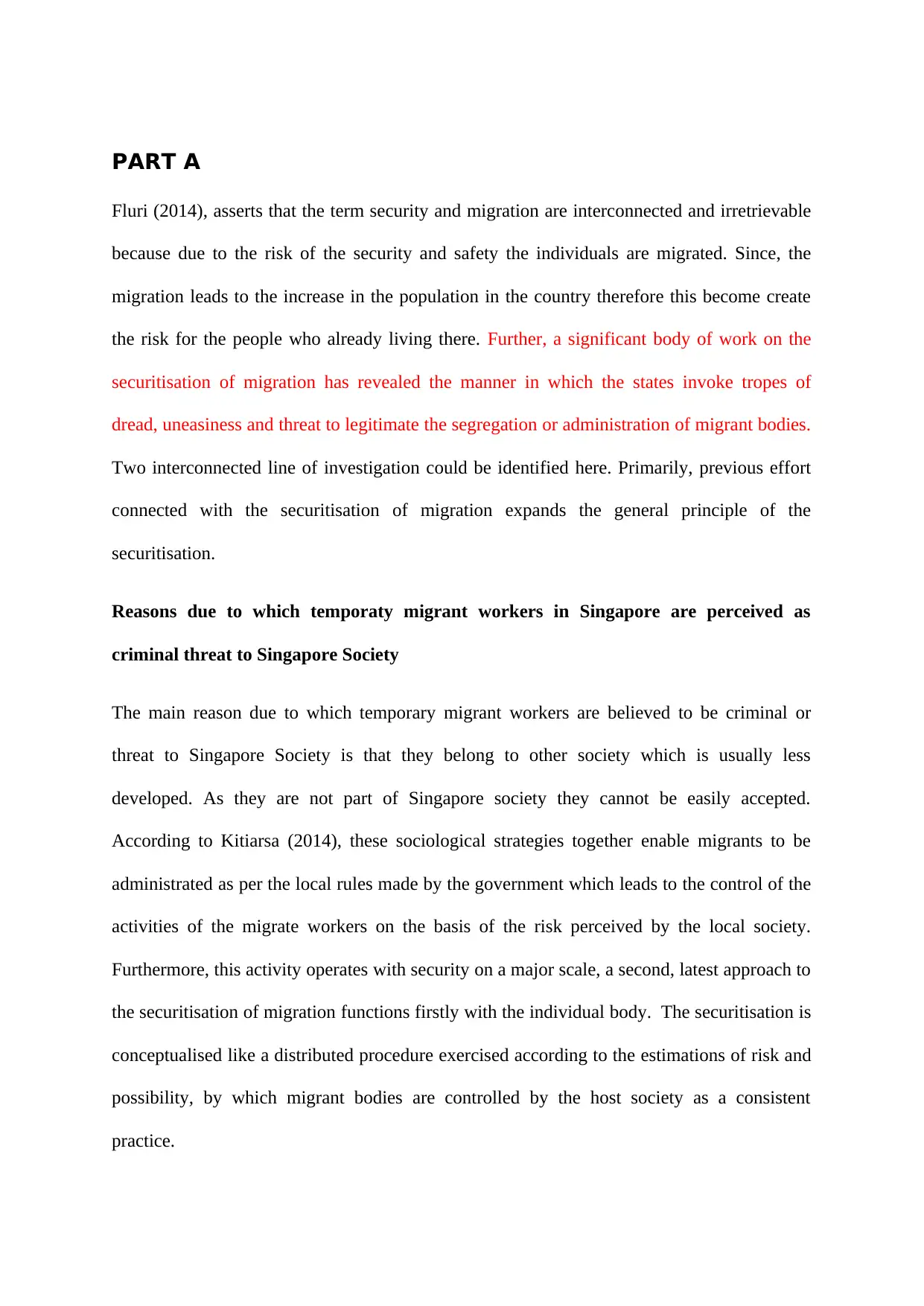
PART A
Fluri (2014), asserts that the term security and migration are interconnected and irretrievable
because due to the risk of the security and safety the individuals are migrated. Since, the
migration leads to the increase in the population in the country therefore this become create
the risk for the people who already living there. Further, a significant body of work on the
securitisation of migration has revealed the manner in which the states invoke tropes of
dread, uneasiness and threat to legitimate the segregation or administration of migrant bodies.
Two interconnected line of investigation could be identified here. Primarily, previous effort
connected with the securitisation of migration expands the general principle of the
securitisation.
Reasons due to which temporaty migrant workers in Singapore are perceived as
criminal threat to Singapore Society
The main reason due to which temporary migrant workers are believed to be criminal or
threat to Singapore Society is that they belong to other society which is usually less
developed. As they are not part of Singapore society they cannot be easily accepted.
According to Kitiarsa (2014), these sociological strategies together enable migrants to be
administrated as per the local rules made by the government which leads to the control of the
activities of the migrate workers on the basis of the risk perceived by the local society.
Furthermore, this activity operates with security on a major scale, a second, latest approach to
the securitisation of migration functions firstly with the individual body. The securitisation is
conceptualised like a distributed procedure exercised according to the estimations of risk and
possibility, by which migrant bodies are controlled by the host society as a consistent
practice.
Fluri (2014), asserts that the term security and migration are interconnected and irretrievable
because due to the risk of the security and safety the individuals are migrated. Since, the
migration leads to the increase in the population in the country therefore this become create
the risk for the people who already living there. Further, a significant body of work on the
securitisation of migration has revealed the manner in which the states invoke tropes of
dread, uneasiness and threat to legitimate the segregation or administration of migrant bodies.
Two interconnected line of investigation could be identified here. Primarily, previous effort
connected with the securitisation of migration expands the general principle of the
securitisation.
Reasons due to which temporaty migrant workers in Singapore are perceived as
criminal threat to Singapore Society
The main reason due to which temporary migrant workers are believed to be criminal or
threat to Singapore Society is that they belong to other society which is usually less
developed. As they are not part of Singapore society they cannot be easily accepted.
According to Kitiarsa (2014), these sociological strategies together enable migrants to be
administrated as per the local rules made by the government which leads to the control of the
activities of the migrate workers on the basis of the risk perceived by the local society.
Furthermore, this activity operates with security on a major scale, a second, latest approach to
the securitisation of migration functions firstly with the individual body. The securitisation is
conceptualised like a distributed procedure exercised according to the estimations of risk and
possibility, by which migrant bodies are controlled by the host society as a consistent
practice.
⊘ This is a preview!⊘
Do you want full access?
Subscribe today to unlock all pages.

Trusted by 1+ million students worldwide
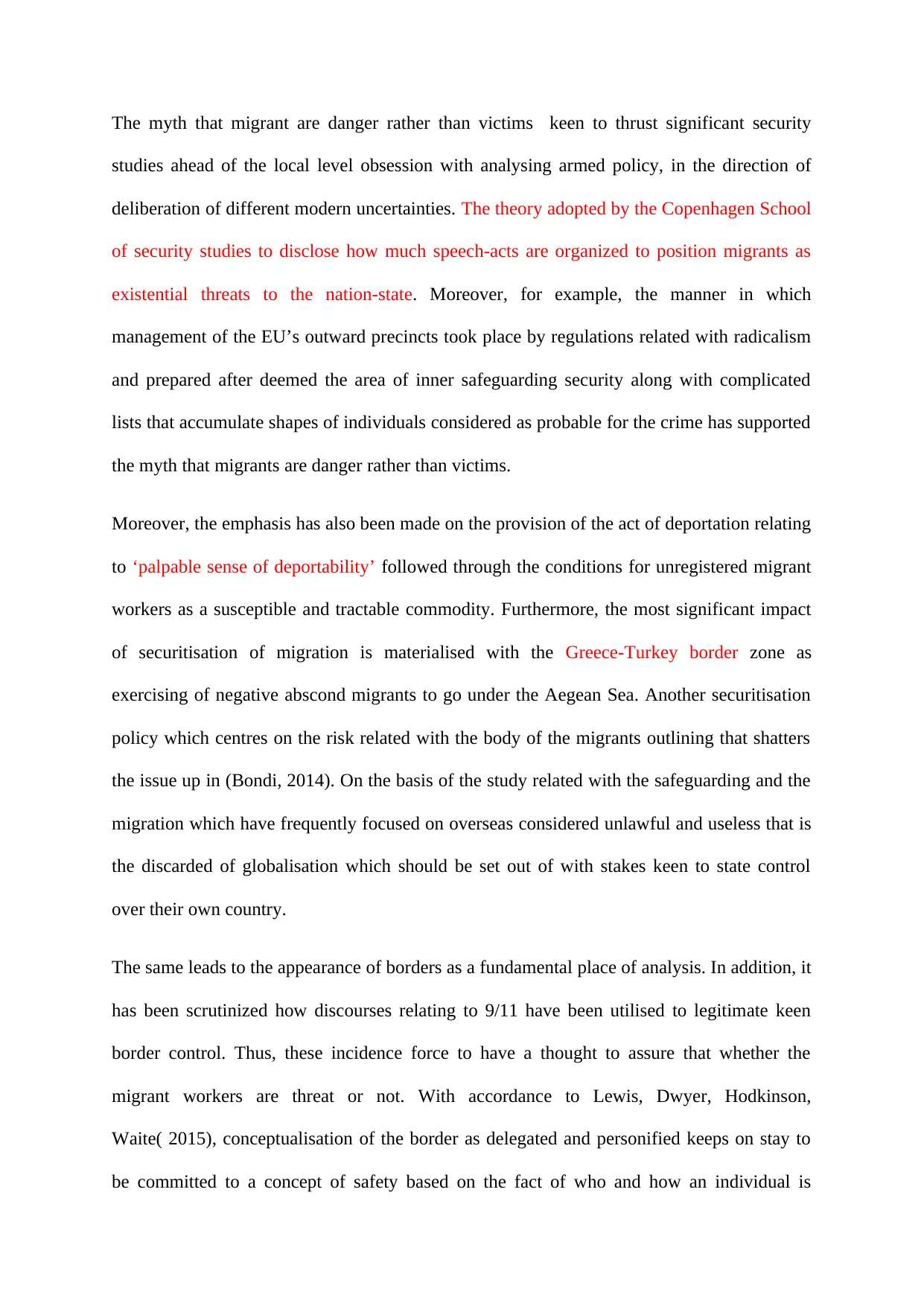
The myth that migrant are danger rather than victims keen to thrust significant security
studies ahead of the local level obsession with analysing armed policy, in the direction of
deliberation of different modern uncertainties. The theory adopted by the Copenhagen School
of security studies to disclose how much speech-acts are organized to position migrants as
existential threats to the nation-state. Moreover, for example, the manner in which
management of the EU’s outward precincts took place by regulations related with radicalism
and prepared after deemed the area of inner safeguarding security along with complicated
lists that accumulate shapes of individuals considered as probable for the crime has supported
the myth that migrants are danger rather than victims.
Moreover, the emphasis has also been made on the provision of the act of deportation relating
to ‘palpable sense of deportability’ followed through the conditions for unregistered migrant
workers as a susceptible and tractable commodity. Furthermore, the most significant impact
of securitisation of migration is materialised with the Greece-Turkey border zone as
exercising of negative abscond migrants to go under the Aegean Sea. Another securitisation
policy which centres on the risk related with the body of the migrants outlining that shatters
the issue up in (Bondi, 2014). On the basis of the study related with the safeguarding and the
migration which have frequently focused on overseas considered unlawful and useless that is
the discarded of globalisation which should be set out of with stakes keen to state control
over their own country.
The same leads to the appearance of borders as a fundamental place of analysis. In addition, it
has been scrutinized how discourses relating to 9/11 have been utilised to legitimate keen
border control. Thus, these incidence force to have a thought to assure that whether the
migrant workers are threat or not. With accordance to Lewis, Dwyer, Hodkinson,
Waite( 2015), conceptualisation of the border as delegated and personified keeps on stay to
be committed to a concept of safety based on the fact of who and how an individual is
studies ahead of the local level obsession with analysing armed policy, in the direction of
deliberation of different modern uncertainties. The theory adopted by the Copenhagen School
of security studies to disclose how much speech-acts are organized to position migrants as
existential threats to the nation-state. Moreover, for example, the manner in which
management of the EU’s outward precincts took place by regulations related with radicalism
and prepared after deemed the area of inner safeguarding security along with complicated
lists that accumulate shapes of individuals considered as probable for the crime has supported
the myth that migrants are danger rather than victims.
Moreover, the emphasis has also been made on the provision of the act of deportation relating
to ‘palpable sense of deportability’ followed through the conditions for unregistered migrant
workers as a susceptible and tractable commodity. Furthermore, the most significant impact
of securitisation of migration is materialised with the Greece-Turkey border zone as
exercising of negative abscond migrants to go under the Aegean Sea. Another securitisation
policy which centres on the risk related with the body of the migrants outlining that shatters
the issue up in (Bondi, 2014). On the basis of the study related with the safeguarding and the
migration which have frequently focused on overseas considered unlawful and useless that is
the discarded of globalisation which should be set out of with stakes keen to state control
over their own country.
The same leads to the appearance of borders as a fundamental place of analysis. In addition, it
has been scrutinized how discourses relating to 9/11 have been utilised to legitimate keen
border control. Thus, these incidence force to have a thought to assure that whether the
migrant workers are threat or not. With accordance to Lewis, Dwyer, Hodkinson,
Waite( 2015), conceptualisation of the border as delegated and personified keeps on stay to
be committed to a concept of safety based on the fact of who and how an individual is
Paraphrase This Document
Need a fresh take? Get an instant paraphrase of this document with our AI Paraphraser
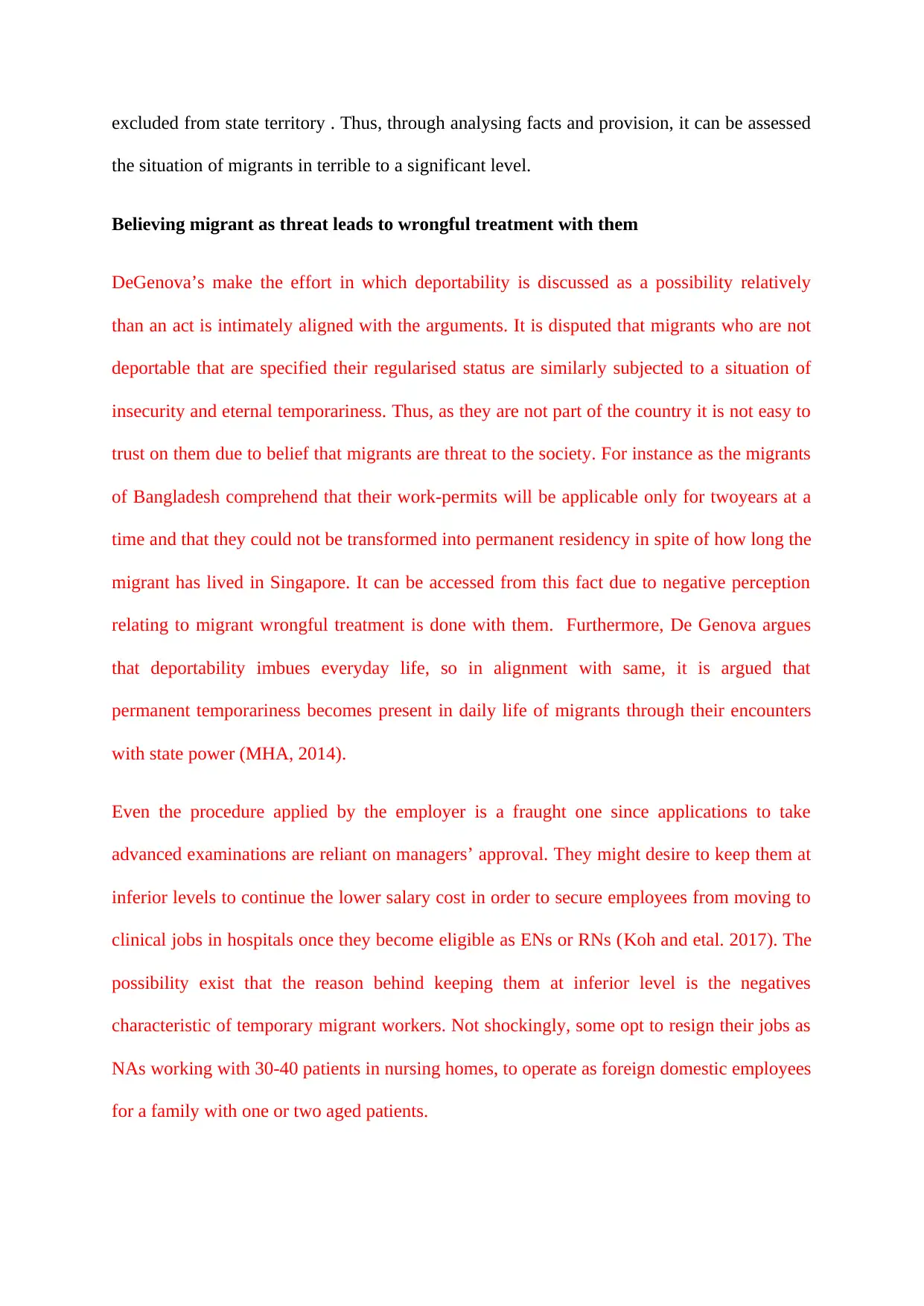
excluded from state territory . Thus, through analysing facts and provision, it can be assessed
the situation of migrants in terrible to a significant level.
Believing migrant as threat leads to wrongful treatment with them
DeGenova’s make the effort in which deportability is discussed as a possibility relatively
than an act is intimately aligned with the arguments. It is disputed that migrants who are not
deportable that are specified their regularised status are similarly subjected to a situation of
insecurity and eternal temporariness. Thus, as they are not part of the country it is not easy to
trust on them due to belief that migrants are threat to the society. For instance as the migrants
of Bangladesh comprehend that their work-permits will be applicable only for twoyears at a
time and that they could not be transformed into permanent residency in spite of how long the
migrant has lived in Singapore. It can be accessed from this fact due to negative perception
relating to migrant wrongful treatment is done with them. Furthermore, De Genova argues
that deportability imbues everyday life, so in alignment with same, it is argued that
permanent temporariness becomes present in daily life of migrants through their encounters
with state power (MHA, 2014).
Even the procedure applied by the employer is a fraught one since applications to take
advanced examinations are reliant on managers’ approval. They might desire to keep them at
inferior levels to continue the lower salary cost in order to secure employees from moving to
clinical jobs in hospitals once they become eligible as ENs or RNs (Koh and etal. 2017). The
possibility exist that the reason behind keeping them at inferior level is the negatives
characteristic of temporary migrant workers. Not shockingly, some opt to resign their jobs as
NAs working with 30-40 patients in nursing homes, to operate as foreign domestic employees
for a family with one or two aged patients.
the situation of migrants in terrible to a significant level.
Believing migrant as threat leads to wrongful treatment with them
DeGenova’s make the effort in which deportability is discussed as a possibility relatively
than an act is intimately aligned with the arguments. It is disputed that migrants who are not
deportable that are specified their regularised status are similarly subjected to a situation of
insecurity and eternal temporariness. Thus, as they are not part of the country it is not easy to
trust on them due to belief that migrants are threat to the society. For instance as the migrants
of Bangladesh comprehend that their work-permits will be applicable only for twoyears at a
time and that they could not be transformed into permanent residency in spite of how long the
migrant has lived in Singapore. It can be accessed from this fact due to negative perception
relating to migrant wrongful treatment is done with them. Furthermore, De Genova argues
that deportability imbues everyday life, so in alignment with same, it is argued that
permanent temporariness becomes present in daily life of migrants through their encounters
with state power (MHA, 2014).
Even the procedure applied by the employer is a fraught one since applications to take
advanced examinations are reliant on managers’ approval. They might desire to keep them at
inferior levels to continue the lower salary cost in order to secure employees from moving to
clinical jobs in hospitals once they become eligible as ENs or RNs (Koh and etal. 2017). The
possibility exist that the reason behind keeping them at inferior level is the negatives
characteristic of temporary migrant workers. Not shockingly, some opt to resign their jobs as
NAs working with 30-40 patients in nursing homes, to operate as foreign domestic employees
for a family with one or two aged patients.
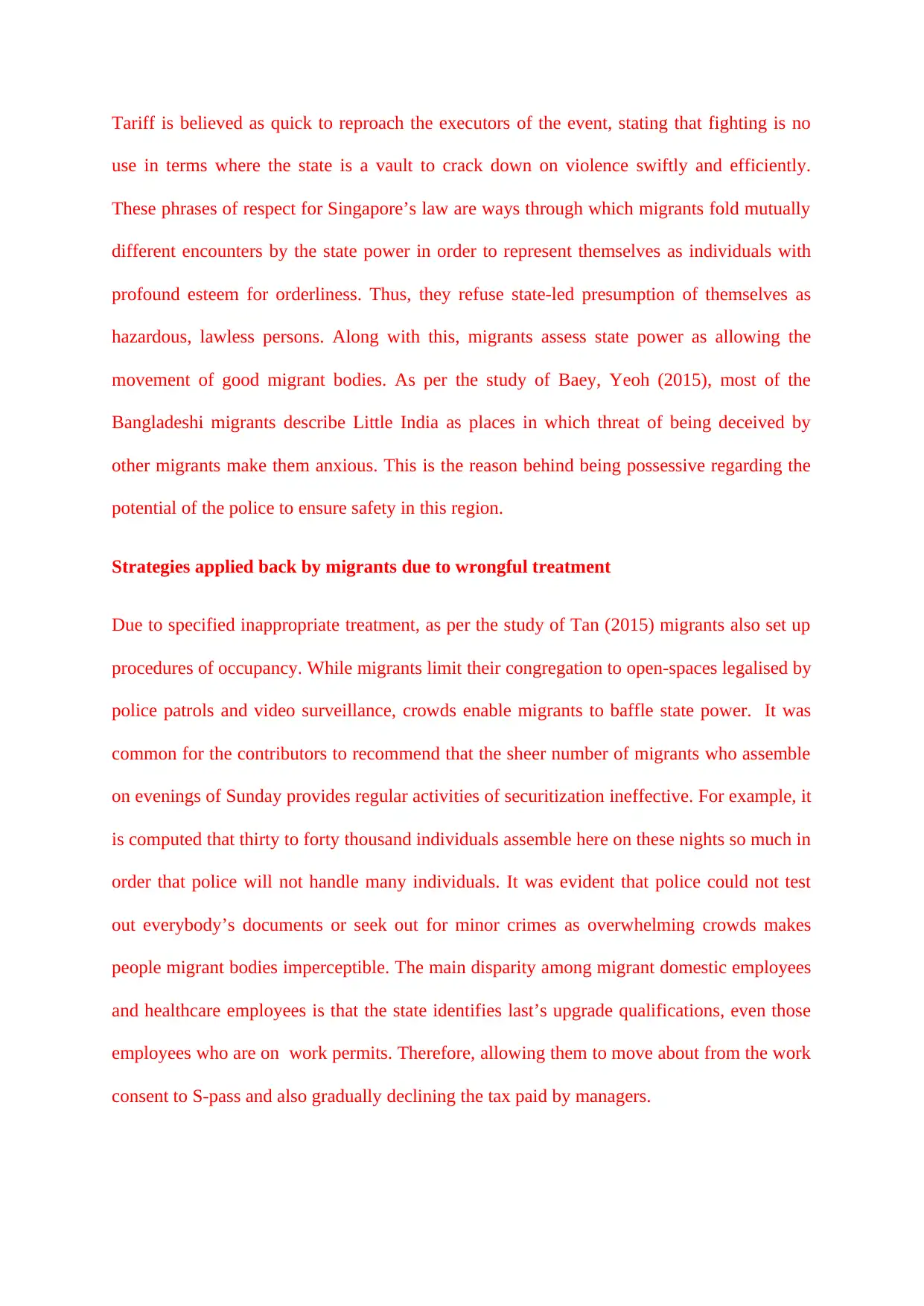
Tariff is believed as quick to reproach the executors of the event, stating that fighting is no
use in terms where the state is a vault to crack down on violence swiftly and efficiently.
These phrases of respect for Singapore’s law are ways through which migrants fold mutually
different encounters by the state power in order to represent themselves as individuals with
profound esteem for orderliness. Thus, they refuse state-led presumption of themselves as
hazardous, lawless persons. Along with this, migrants assess state power as allowing the
movement of good migrant bodies. As per the study of Baey, Yeoh (2015), most of the
Bangladeshi migrants describe Little India as places in which threat of being deceived by
other migrants make them anxious. This is the reason behind being possessive regarding the
potential of the police to ensure safety in this region.
Strategies applied back by migrants due to wrongful treatment
Due to specified inappropriate treatment, as per the study of Tan (2015) migrants also set up
procedures of occupancy. While migrants limit their congregation to open-spaces legalised by
police patrols and video surveillance, crowds enable migrants to baffle state power. It was
common for the contributors to recommend that the sheer number of migrants who assemble
on evenings of Sunday provides regular activities of securitization ineffective. For example, it
is computed that thirty to forty thousand individuals assemble here on these nights so much in
order that police will not handle many individuals. It was evident that police could not test
out everybody’s documents or seek out for minor crimes as overwhelming crowds makes
people migrant bodies imperceptible. The main disparity among migrant domestic employees
and healthcare employees is that the state identifies last’s upgrade qualifications, even those
employees who are on work permits. Therefore, allowing them to move about from the work
consent to S-pass and also gradually declining the tax paid by managers.
use in terms where the state is a vault to crack down on violence swiftly and efficiently.
These phrases of respect for Singapore’s law are ways through which migrants fold mutually
different encounters by the state power in order to represent themselves as individuals with
profound esteem for orderliness. Thus, they refuse state-led presumption of themselves as
hazardous, lawless persons. Along with this, migrants assess state power as allowing the
movement of good migrant bodies. As per the study of Baey, Yeoh (2015), most of the
Bangladeshi migrants describe Little India as places in which threat of being deceived by
other migrants make them anxious. This is the reason behind being possessive regarding the
potential of the police to ensure safety in this region.
Strategies applied back by migrants due to wrongful treatment
Due to specified inappropriate treatment, as per the study of Tan (2015) migrants also set up
procedures of occupancy. While migrants limit their congregation to open-spaces legalised by
police patrols and video surveillance, crowds enable migrants to baffle state power. It was
common for the contributors to recommend that the sheer number of migrants who assemble
on evenings of Sunday provides regular activities of securitization ineffective. For example, it
is computed that thirty to forty thousand individuals assemble here on these nights so much in
order that police will not handle many individuals. It was evident that police could not test
out everybody’s documents or seek out for minor crimes as overwhelming crowds makes
people migrant bodies imperceptible. The main disparity among migrant domestic employees
and healthcare employees is that the state identifies last’s upgrade qualifications, even those
employees who are on work permits. Therefore, allowing them to move about from the work
consent to S-pass and also gradually declining the tax paid by managers.
⊘ This is a preview!⊘
Do you want full access?
Subscribe today to unlock all pages.

Trusted by 1+ million students worldwide
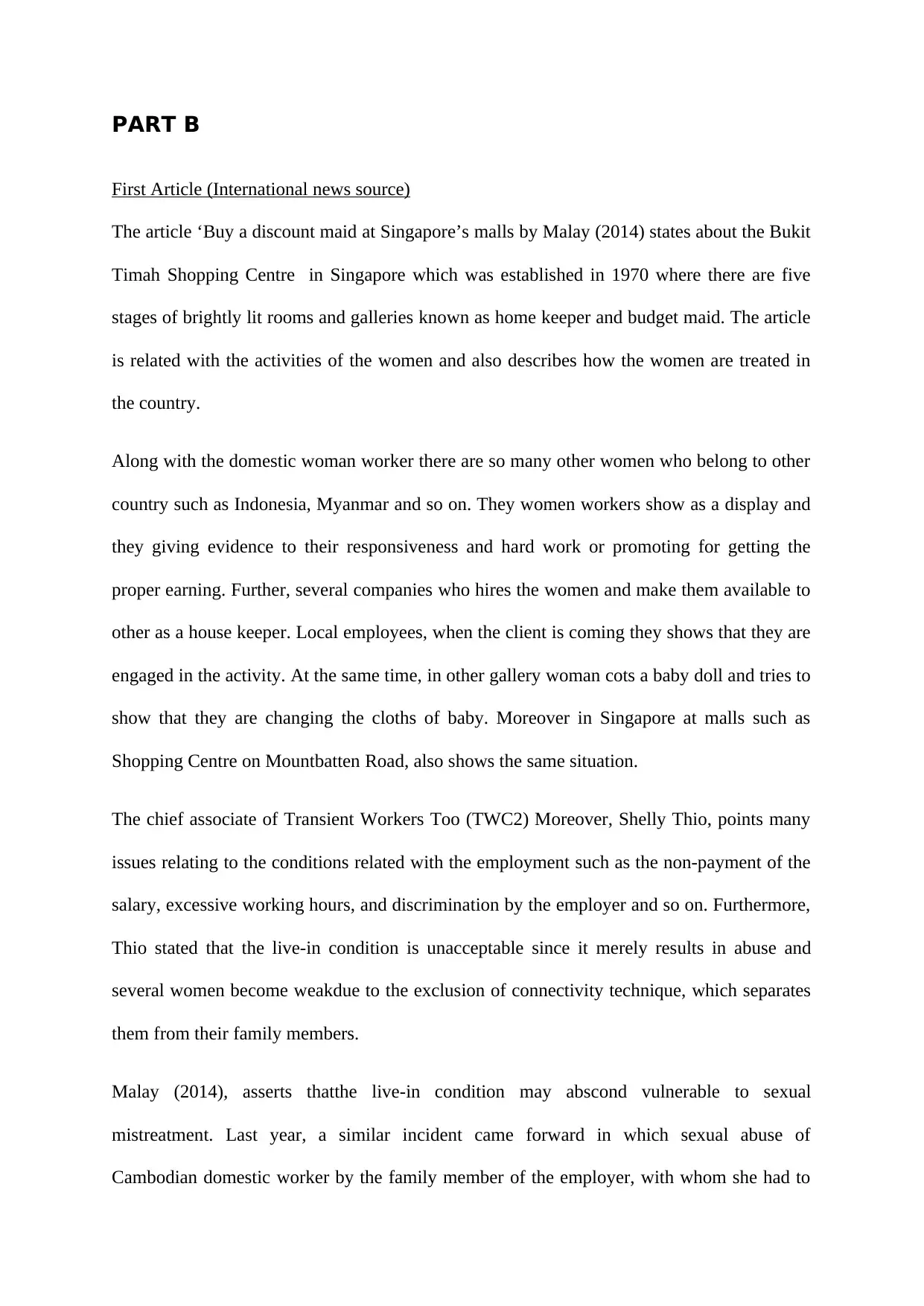
PART B
First Article (International news source)
The article ‘Buy a discount maid at Singapore’s malls by Malay (2014) states about the Bukit
Timah Shopping Centre in Singapore which was established in 1970 where there are five
stages of brightly lit rooms and galleries known as home keeper and budget maid. The article
is related with the activities of the women and also describes how the women are treated in
the country.
Along with the domestic woman worker there are so many other women who belong to other
country such as Indonesia, Myanmar and so on. They women workers show as a display and
they giving evidence to their responsiveness and hard work or promoting for getting the
proper earning. Further, several companies who hires the women and make them available to
other as a house keeper. Local employees, when the client is coming they shows that they are
engaged in the activity. At the same time, in other gallery woman cots a baby doll and tries to
show that they are changing the cloths of baby. Moreover in Singapore at malls such as
Shopping Centre on Mountbatten Road, also shows the same situation.
The chief associate of Transient Workers Too (TWC2) Moreover, Shelly Thio, points many
issues relating to the conditions related with the employment such as the non-payment of the
salary, excessive working hours, and discrimination by the employer and so on. Furthermore,
Thio stated that the live-in condition is unacceptable since it merely results in abuse and
several women become weakdue to the exclusion of connectivity technique, which separates
them from their family members.
Malay (2014), asserts thatthe live-in condition may abscond vulnerable to sexual
mistreatment. Last year, a similar incident came forward in which sexual abuse of
Cambodian domestic worker by the family member of the employer, with whom she had to
First Article (International news source)
The article ‘Buy a discount maid at Singapore’s malls by Malay (2014) states about the Bukit
Timah Shopping Centre in Singapore which was established in 1970 where there are five
stages of brightly lit rooms and galleries known as home keeper and budget maid. The article
is related with the activities of the women and also describes how the women are treated in
the country.
Along with the domestic woman worker there are so many other women who belong to other
country such as Indonesia, Myanmar and so on. They women workers show as a display and
they giving evidence to their responsiveness and hard work or promoting for getting the
proper earning. Further, several companies who hires the women and make them available to
other as a house keeper. Local employees, when the client is coming they shows that they are
engaged in the activity. At the same time, in other gallery woman cots a baby doll and tries to
show that they are changing the cloths of baby. Moreover in Singapore at malls such as
Shopping Centre on Mountbatten Road, also shows the same situation.
The chief associate of Transient Workers Too (TWC2) Moreover, Shelly Thio, points many
issues relating to the conditions related with the employment such as the non-payment of the
salary, excessive working hours, and discrimination by the employer and so on. Furthermore,
Thio stated that the live-in condition is unacceptable since it merely results in abuse and
several women become weakdue to the exclusion of connectivity technique, which separates
them from their family members.
Malay (2014), asserts thatthe live-in condition may abscond vulnerable to sexual
mistreatment. Last year, a similar incident came forward in which sexual abuse of
Cambodian domestic worker by the family member of the employer, with whom she had to
Paraphrase This Document
Need a fresh take? Get an instant paraphrase of this document with our AI Paraphraser
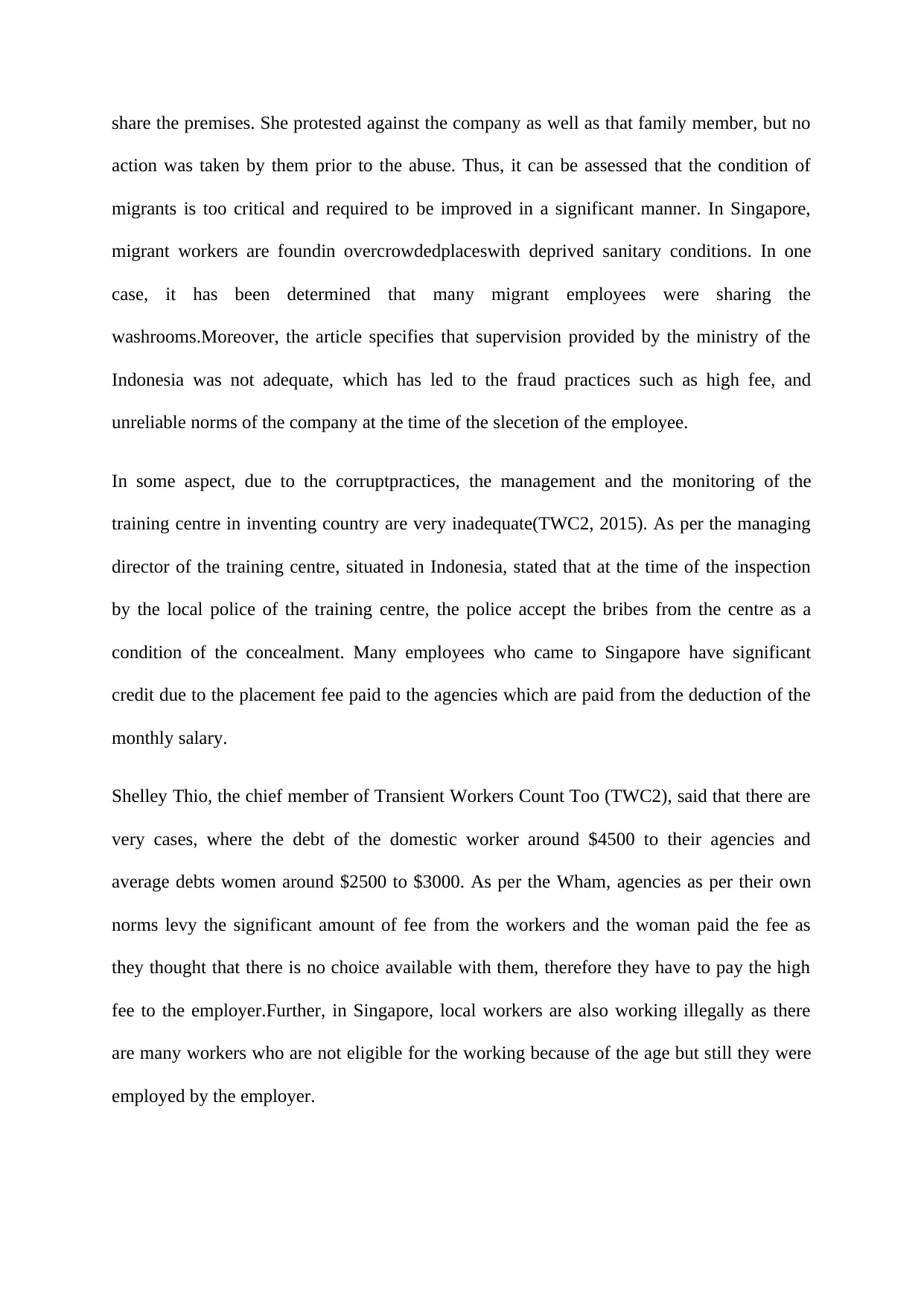
share the premises. She protested against the company as well as that family member, but no
action was taken by them prior to the abuse. Thus, it can be assessed that the condition of
migrants is too critical and required to be improved in a significant manner. In Singapore,
migrant workers are foundin overcrowdedplaceswith deprived sanitary conditions. In one
case, it has been determined that many migrant employees were sharing the
washrooms.Moreover, the article specifies that supervision provided by the ministry of the
Indonesia was not adequate, which has led to the fraud practices such as high fee, and
unreliable norms of the company at the time of the slecetion of the employee.
In some aspect, due to the corruptpractices, the management and the monitoring of the
training centre in inventing country are very inadequate(TWC2, 2015). As per the managing
director of the training centre, situated in Indonesia, stated that at the time of the inspection
by the local police of the training centre, the police accept the bribes from the centre as a
condition of the concealment. Many employees who came to Singapore have significant
credit due to the placement fee paid to the agencies which are paid from the deduction of the
monthly salary.
Shelley Thio, the chief member of Transient Workers Count Too (TWC2), said that there are
very cases, where the debt of the domestic worker around $4500 to their agencies and
average debts women around $2500 to $3000. As per the Wham, agencies as per their own
norms levy the significant amount of fee from the workers and the woman paid the fee as
they thought that there is no choice available with them, therefore they have to pay the high
fee to the employer.Further, in Singapore, local workers are also working illegally as there
are many workers who are not eligible for the working because of the age but still they were
employed by the employer.
action was taken by them prior to the abuse. Thus, it can be assessed that the condition of
migrants is too critical and required to be improved in a significant manner. In Singapore,
migrant workers are foundin overcrowdedplaceswith deprived sanitary conditions. In one
case, it has been determined that many migrant employees were sharing the
washrooms.Moreover, the article specifies that supervision provided by the ministry of the
Indonesia was not adequate, which has led to the fraud practices such as high fee, and
unreliable norms of the company at the time of the slecetion of the employee.
In some aspect, due to the corruptpractices, the management and the monitoring of the
training centre in inventing country are very inadequate(TWC2, 2015). As per the managing
director of the training centre, situated in Indonesia, stated that at the time of the inspection
by the local police of the training centre, the police accept the bribes from the centre as a
condition of the concealment. Many employees who came to Singapore have significant
credit due to the placement fee paid to the agencies which are paid from the deduction of the
monthly salary.
Shelley Thio, the chief member of Transient Workers Count Too (TWC2), said that there are
very cases, where the debt of the domestic worker around $4500 to their agencies and
average debts women around $2500 to $3000. As per the Wham, agencies as per their own
norms levy the significant amount of fee from the workers and the woman paid the fee as
they thought that there is no choice available with them, therefore they have to pay the high
fee to the employer.Further, in Singapore, local workers are also working illegally as there
are many workers who are not eligible for the working because of the age but still they were
employed by the employer.
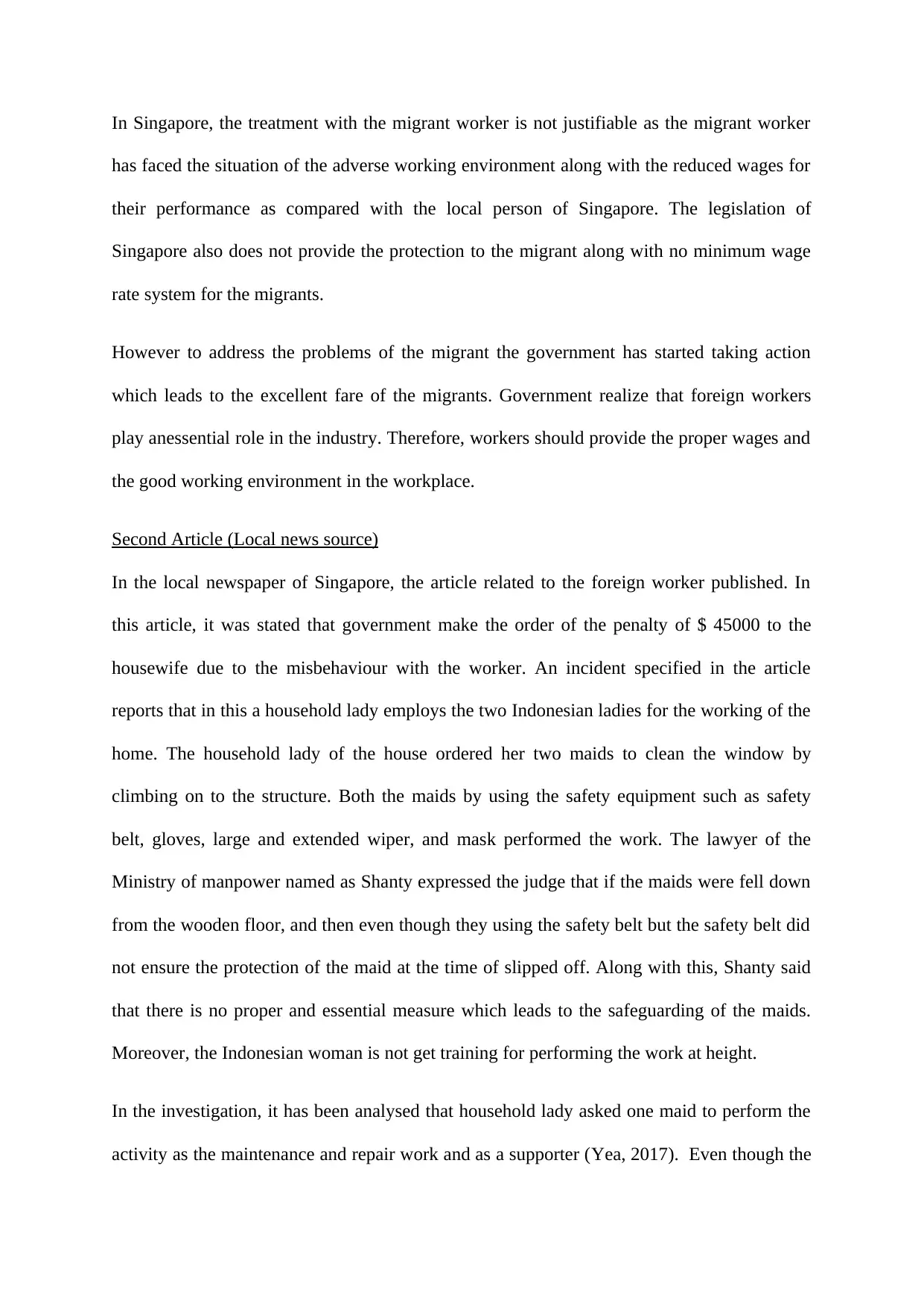
In Singapore, the treatment with the migrant worker is not justifiable as the migrant worker
has faced the situation of the adverse working environment along with the reduced wages for
their performance as compared with the local person of Singapore. The legislation of
Singapore also does not provide the protection to the migrant along with no minimum wage
rate system for the migrants.
However to address the problems of the migrant the government has started taking action
which leads to the excellent fare of the migrants. Government realize that foreign workers
play anessential role in the industry. Therefore, workers should provide the proper wages and
the good working environment in the workplace.
Second Article (Local news source)
In the local newspaper of Singapore, the article related to the foreign worker published. In
this article, it was stated that government make the order of the penalty of $ 45000 to the
housewife due to the misbehaviour with the worker. An incident specified in the article
reports that in this a household lady employs the two Indonesian ladies for the working of the
home. The household lady of the house ordered her two maids to clean the window by
climbing on to the structure. Both the maids by using the safety equipment such as safety
belt, gloves, large and extended wiper, and mask performed the work. The lawyer of the
Ministry of manpower named as Shanty expressed the judge that if the maids were fell down
from the wooden floor, and then even though they using the safety belt but the safety belt did
not ensure the protection of the maid at the time of slipped off. Along with this, Shanty said
that there is no proper and essential measure which leads to the safeguarding of the maids.
Moreover, the Indonesian woman is not get training for performing the work at height.
In the investigation, it has been analysed that household lady asked one maid to perform the
activity as the maintenance and repair work and as a supporter (Yea, 2017). Even though the
has faced the situation of the adverse working environment along with the reduced wages for
their performance as compared with the local person of Singapore. The legislation of
Singapore also does not provide the protection to the migrant along with no minimum wage
rate system for the migrants.
However to address the problems of the migrant the government has started taking action
which leads to the excellent fare of the migrants. Government realize that foreign workers
play anessential role in the industry. Therefore, workers should provide the proper wages and
the good working environment in the workplace.
Second Article (Local news source)
In the local newspaper of Singapore, the article related to the foreign worker published. In
this article, it was stated that government make the order of the penalty of $ 45000 to the
housewife due to the misbehaviour with the worker. An incident specified in the article
reports that in this a household lady employs the two Indonesian ladies for the working of the
home. The household lady of the house ordered her two maids to clean the window by
climbing on to the structure. Both the maids by using the safety equipment such as safety
belt, gloves, large and extended wiper, and mask performed the work. The lawyer of the
Ministry of manpower named as Shanty expressed the judge that if the maids were fell down
from the wooden floor, and then even though they using the safety belt but the safety belt did
not ensure the protection of the maid at the time of slipped off. Along with this, Shanty said
that there is no proper and essential measure which leads to the safeguarding of the maids.
Moreover, the Indonesian woman is not get training for performing the work at height.
In the investigation, it has been analysed that household lady asked one maid to perform the
activity as the maintenance and repair work and as a supporter (Yea, 2017). Even though the
⊘ This is a preview!⊘
Do you want full access?
Subscribe today to unlock all pages.

Trusted by 1+ million students worldwide
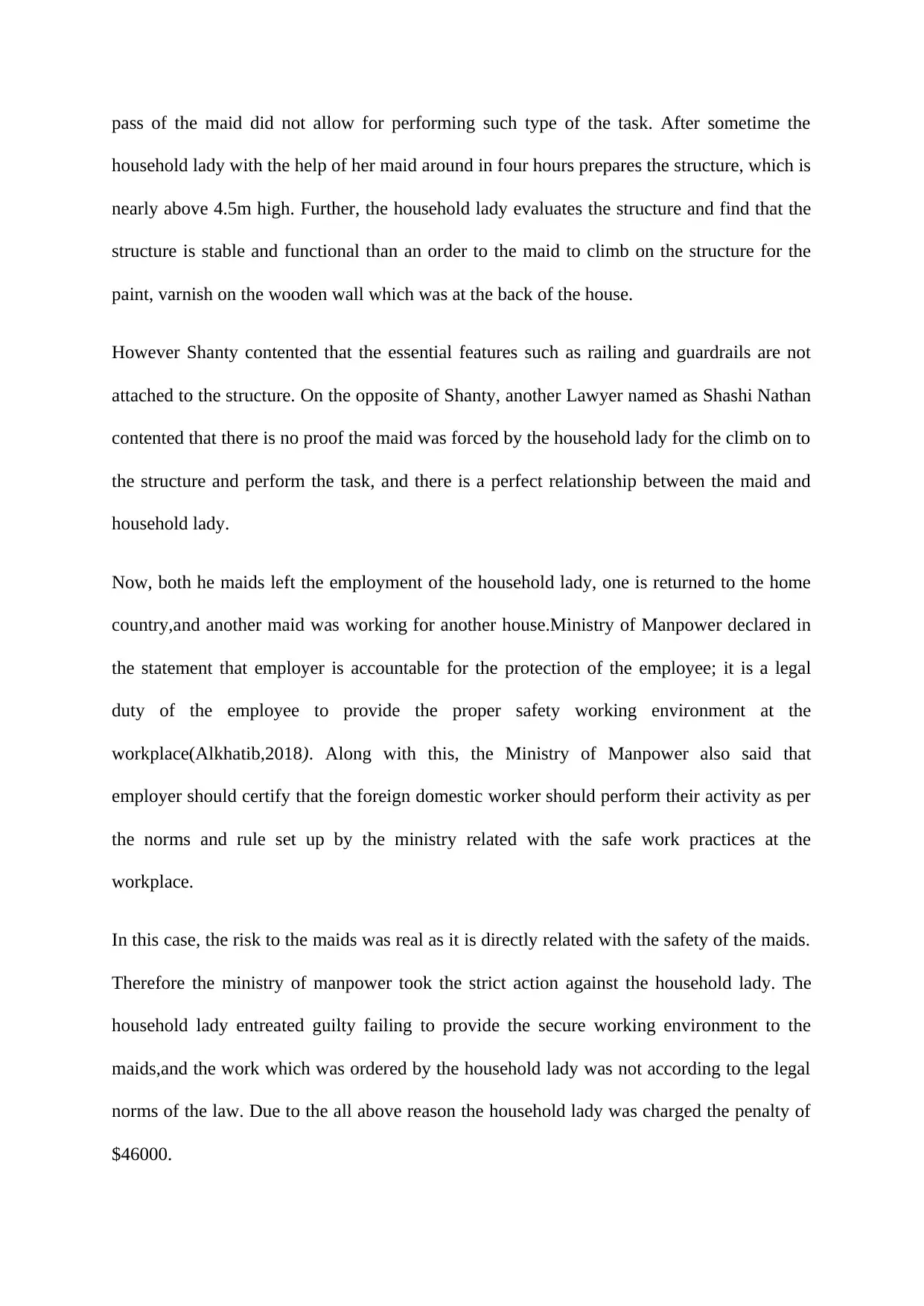
pass of the maid did not allow for performing such type of the task. After sometime the
household lady with the help of her maid around in four hours prepares the structure, which is
nearly above 4.5m high. Further, the household lady evaluates the structure and find that the
structure is stable and functional than an order to the maid to climb on the structure for the
paint, varnish on the wooden wall which was at the back of the house.
However Shanty contented that the essential features such as railing and guardrails are not
attached to the structure. On the opposite of Shanty, another Lawyer named as Shashi Nathan
contented that there is no proof the maid was forced by the household lady for the climb on to
the structure and perform the task, and there is a perfect relationship between the maid and
household lady.
Now, both he maids left the employment of the household lady, one is returned to the home
country,and another maid was working for another house.Ministry of Manpower declared in
the statement that employer is accountable for the protection of the employee; it is a legal
duty of the employee to provide the proper safety working environment at the
workplace(Alkhatib,2018). Along with this, the Ministry of Manpower also said that
employer should certify that the foreign domestic worker should perform their activity as per
the norms and rule set up by the ministry related with the safe work practices at the
workplace.
In this case, the risk to the maids was real as it is directly related with the safety of the maids.
Therefore the ministry of manpower took the strict action against the household lady. The
household lady entreated guilty failing to provide the secure working environment to the
maids,and the work which was ordered by the household lady was not according to the legal
norms of the law. Due to the all above reason the household lady was charged the penalty of
$46000.
household lady with the help of her maid around in four hours prepares the structure, which is
nearly above 4.5m high. Further, the household lady evaluates the structure and find that the
structure is stable and functional than an order to the maid to climb on the structure for the
paint, varnish on the wooden wall which was at the back of the house.
However Shanty contented that the essential features such as railing and guardrails are not
attached to the structure. On the opposite of Shanty, another Lawyer named as Shashi Nathan
contented that there is no proof the maid was forced by the household lady for the climb on to
the structure and perform the task, and there is a perfect relationship between the maid and
household lady.
Now, both he maids left the employment of the household lady, one is returned to the home
country,and another maid was working for another house.Ministry of Manpower declared in
the statement that employer is accountable for the protection of the employee; it is a legal
duty of the employee to provide the proper safety working environment at the
workplace(Alkhatib,2018). Along with this, the Ministry of Manpower also said that
employer should certify that the foreign domestic worker should perform their activity as per
the norms and rule set up by the ministry related with the safe work practices at the
workplace.
In this case, the risk to the maids was real as it is directly related with the safety of the maids.
Therefore the ministry of manpower took the strict action against the household lady. The
household lady entreated guilty failing to provide the secure working environment to the
maids,and the work which was ordered by the household lady was not according to the legal
norms of the law. Due to the all above reason the household lady was charged the penalty of
$46000.
Paraphrase This Document
Need a fresh take? Get an instant paraphrase of this document with our AI Paraphraser
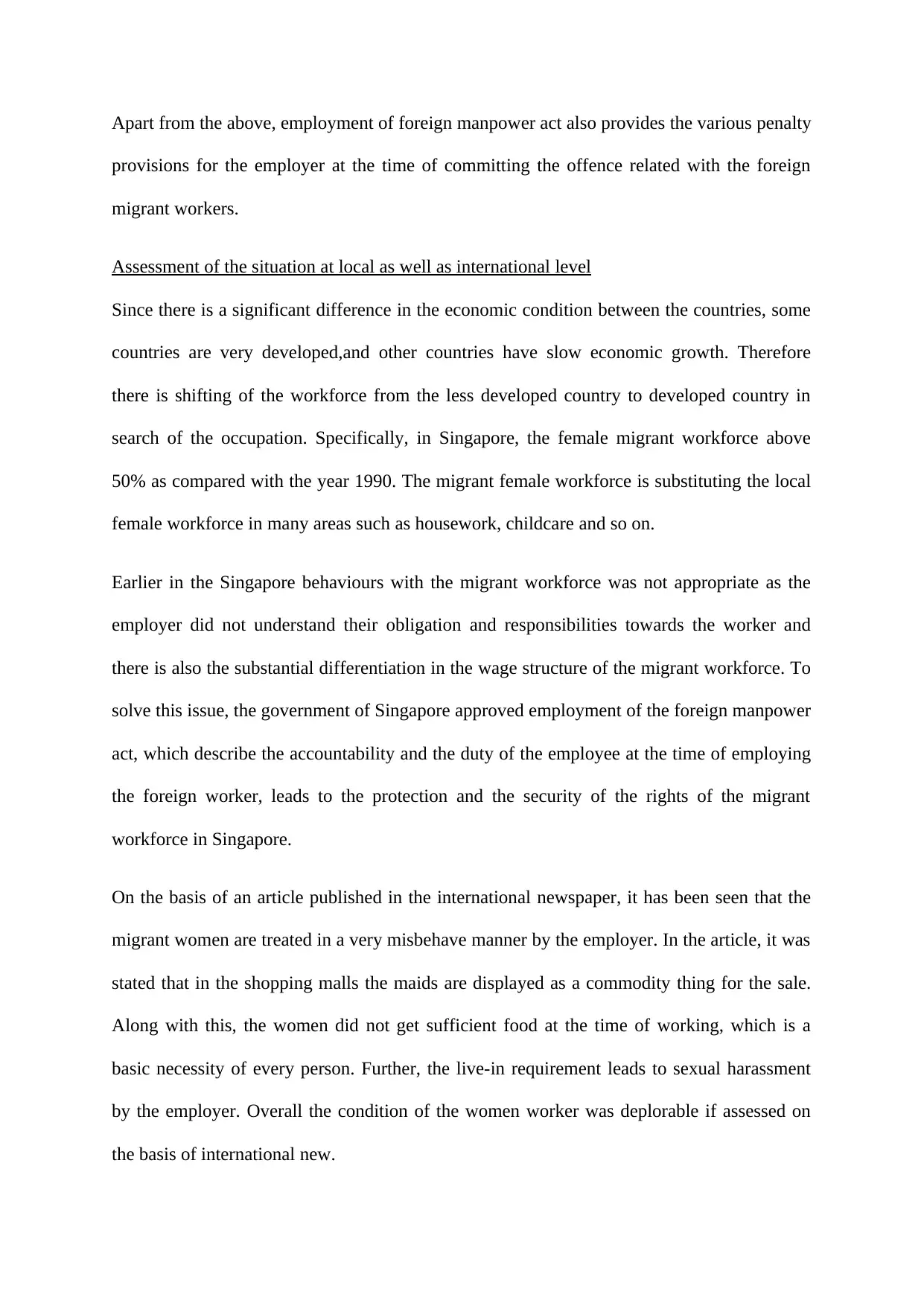
Apart from the above, employment of foreign manpower act also provides the various penalty
provisions for the employer at the time of committing the offence related with the foreign
migrant workers.
Assessment of the situation at local as well as international level
Since there is a significant difference in the economic condition between the countries, some
countries are very developed,and other countries have slow economic growth. Therefore
there is shifting of the workforce from the less developed country to developed country in
search of the occupation. Specifically, in Singapore, the female migrant workforce above
50% as compared with the year 1990. The migrant female workforce is substituting the local
female workforce in many areas such as housework, childcare and so on.
Earlier in the Singapore behaviours with the migrant workforce was not appropriate as the
employer did not understand their obligation and responsibilities towards the worker and
there is also the substantial differentiation in the wage structure of the migrant workforce. To
solve this issue, the government of Singapore approved employment of the foreign manpower
act, which describe the accountability and the duty of the employee at the time of employing
the foreign worker, leads to the protection and the security of the rights of the migrant
workforce in Singapore.
On the basis of an article published in the international newspaper, it has been seen that the
migrant women are treated in a very misbehave manner by the employer. In the article, it was
stated that in the shopping malls the maids are displayed as a commodity thing for the sale.
Along with this, the women did not get sufficient food at the time of working, which is a
basic necessity of every person. Further, the live-in requirement leads to sexual harassment
by the employer. Overall the condition of the women worker was deplorable if assessed on
the basis of international new.
provisions for the employer at the time of committing the offence related with the foreign
migrant workers.
Assessment of the situation at local as well as international level
Since there is a significant difference in the economic condition between the countries, some
countries are very developed,and other countries have slow economic growth. Therefore
there is shifting of the workforce from the less developed country to developed country in
search of the occupation. Specifically, in Singapore, the female migrant workforce above
50% as compared with the year 1990. The migrant female workforce is substituting the local
female workforce in many areas such as housework, childcare and so on.
Earlier in the Singapore behaviours with the migrant workforce was not appropriate as the
employer did not understand their obligation and responsibilities towards the worker and
there is also the substantial differentiation in the wage structure of the migrant workforce. To
solve this issue, the government of Singapore approved employment of the foreign manpower
act, which describe the accountability and the duty of the employee at the time of employing
the foreign worker, leads to the protection and the security of the rights of the migrant
workforce in Singapore.
On the basis of an article published in the international newspaper, it has been seen that the
migrant women are treated in a very misbehave manner by the employer. In the article, it was
stated that in the shopping malls the maids are displayed as a commodity thing for the sale.
Along with this, the women did not get sufficient food at the time of working, which is a
basic necessity of every person. Further, the live-in requirement leads to sexual harassment
by the employer. Overall the condition of the women worker was deplorable if assessed on
the basis of international new.
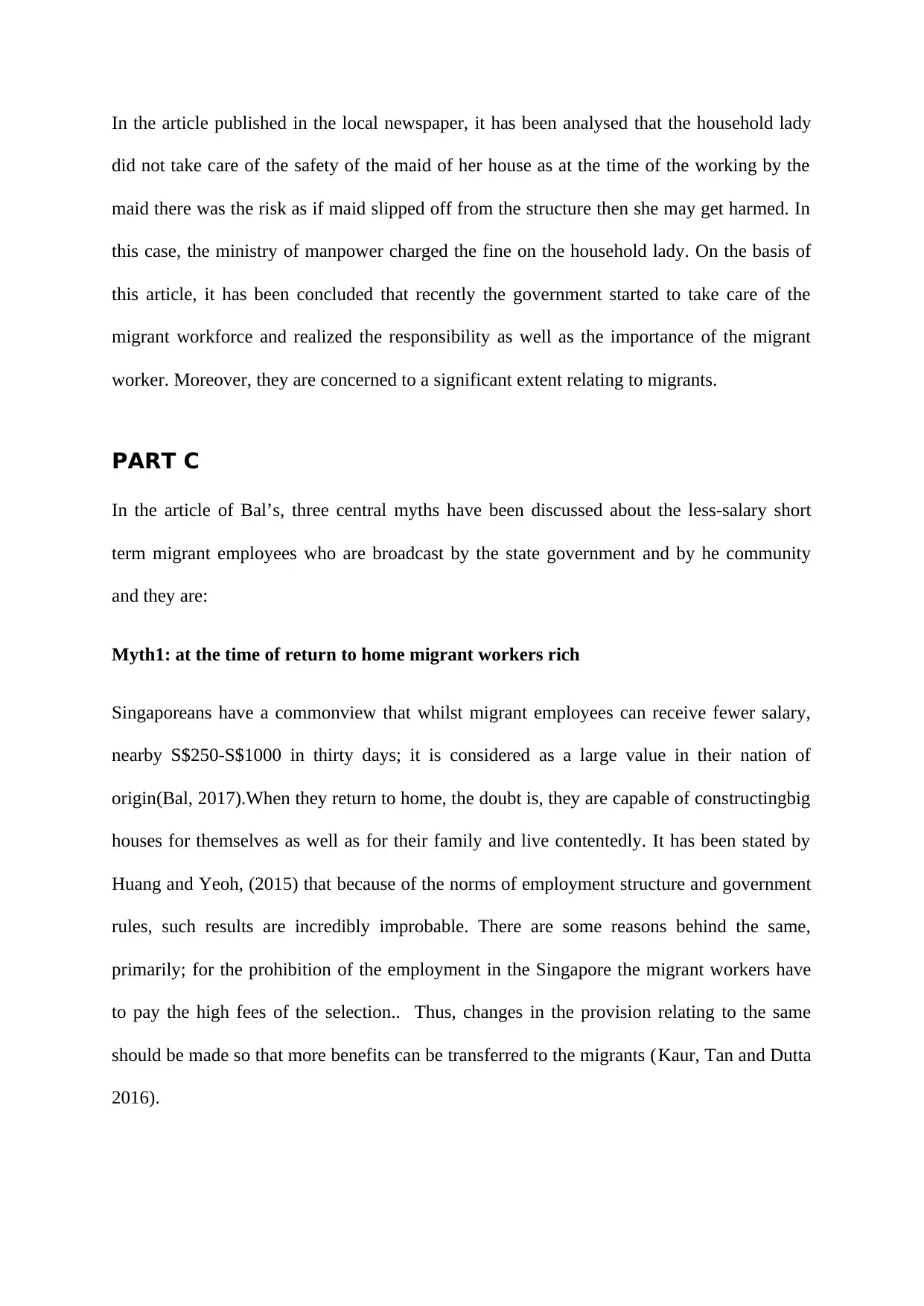
In the article published in the local newspaper, it has been analysed that the household lady
did not take care of the safety of the maid of her house as at the time of the working by the
maid there was the risk as if maid slipped off from the structure then she may get harmed. In
this case, the ministry of manpower charged the fine on the household lady. On the basis of
this article, it has been concluded that recently the government started to take care of the
migrant workforce and realized the responsibility as well as the importance of the migrant
worker. Moreover, they are concerned to a significant extent relating to migrants.
PART C
In the article of Bal’s, three central myths have been discussed about the less-salary short
term migrant employees who are broadcast by the state government and by he community
and they are:
Myth1: at the time of return to home migrant workers rich
Singaporeans have a commonview that whilst migrant employees can receive fewer salary,
nearby S$250-S$1000 in thirty days; it is considered as a large value in their nation of
origin(Bal, 2017).When they return to home, the doubt is, they are capable of constructingbig
houses for themselves as well as for their family and live contentedly. It has been stated by
Huang and Yeoh, (2015) that because of the norms of employment structure and government
rules, such results are incredibly improbable. There are some reasons behind the same,
primarily; for the prohibition of the employment in the Singapore the migrant workers have
to pay the high fees of the selection.. Thus, changes in the provision relating to the same
should be made so that more benefits can be transferred to the migrants (Kaur, Tan and Dutta
2016).
did not take care of the safety of the maid of her house as at the time of the working by the
maid there was the risk as if maid slipped off from the structure then she may get harmed. In
this case, the ministry of manpower charged the fine on the household lady. On the basis of
this article, it has been concluded that recently the government started to take care of the
migrant workforce and realized the responsibility as well as the importance of the migrant
worker. Moreover, they are concerned to a significant extent relating to migrants.
PART C
In the article of Bal’s, three central myths have been discussed about the less-salary short
term migrant employees who are broadcast by the state government and by he community
and they are:
Myth1: at the time of return to home migrant workers rich
Singaporeans have a commonview that whilst migrant employees can receive fewer salary,
nearby S$250-S$1000 in thirty days; it is considered as a large value in their nation of
origin(Bal, 2017).When they return to home, the doubt is, they are capable of constructingbig
houses for themselves as well as for their family and live contentedly. It has been stated by
Huang and Yeoh, (2015) that because of the norms of employment structure and government
rules, such results are incredibly improbable. There are some reasons behind the same,
primarily; for the prohibition of the employment in the Singapore the migrant workers have
to pay the high fees of the selection.. Thus, changes in the provision relating to the same
should be made so that more benefits can be transferred to the migrants (Kaur, Tan and Dutta
2016).
⊘ This is a preview!⊘
Do you want full access?
Subscribe today to unlock all pages.

Trusted by 1+ million students worldwide
1 out of 17
Your All-in-One AI-Powered Toolkit for Academic Success.
+13062052269
info@desklib.com
Available 24*7 on WhatsApp / Email
![[object Object]](/_next/static/media/star-bottom.7253800d.svg)
Unlock your academic potential
Copyright © 2020–2025 A2Z Services. All Rights Reserved. Developed and managed by ZUCOL.